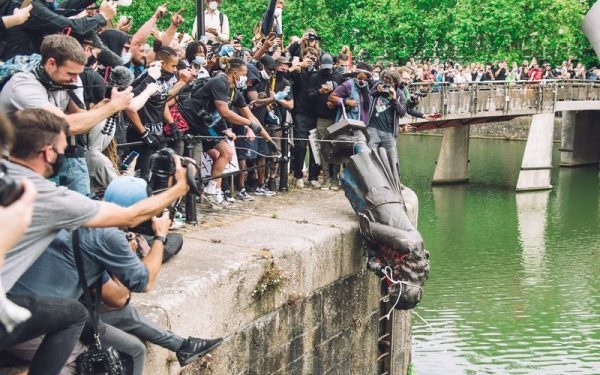The statue of slave trader Edward Colston is pushed into the River Avon, Bristol, UK, June 7, 2020 (Nur Photo/Getty)
Co-written with Scott Lucas:
In Bristol in southwest England, demonstrators topple the statue of slave trader Edward Colston and throw it in the river. In east London, the statue of slave trader Robert Milligan is removed from the Docklands by the River Thames. In Oxford, the governing body of Oriel College votes to take down the statue of Cecil Rhodes, who supported apartheid-style measures in southern Africa.
The Black Lives Matter protests, following the May 25 murder of George Floyd at the hands of Minneapolis police, have spurred marches throughout the UK. But this is not just a transposition of issues such as police violence. Much of the context here is the confrontation of the glorified image of Britain’s imperial past, overlaying inferiority and subjugation.
The protests over the statues present diversity in a 21st-century UK with multiculturalism at its core. Far from telling a “lie of history”, as Prime Minister Boris Johnson jabbed, the removal of the monuments sets the challenge of whether there can be progress from the imperial past to a better future for all — however painful the process may be for some.
Empire Falls
Since the mid-18th Century, British and European wealth grew on the back of imperial territories and their peoples. That expansion fuelled a patriotism and nationalist sentiment which is far from a distant past — the former Rhodesia became Zambia and Zimbabwe only 40 years ago, a war was fought for the Falkland Islands in 1982, and Hong Kong only reverted to China in 1997.
In a YouGov poll in 2014, almost 60% of UK residents said they are “proud” of the empire and what it achieved, compared with 19% who were ashamed of it.
But now violence towards African Americans by authorities more than 4000 miles away has ignited the flame of controversy about what it means to be British in the 21st century, highlighting the economic and social inequalities for those within the BAME community.
So the names of Colston and Milligan are retrieved from history as “Empire” is re-examined. Rhodes’ status as benefactor is stripped away. Attention is now upon his belief, “We are the finest race in the world“, as he brutally installed British rule via his Chartered British South Africa Company, killing more than 60,000 black Southern Africans and enslaving others as “Rhodesia” was christened. The 2015 “Rhodes Must Fall” campaign becomes 2020’s “Rhodes Finally Fell.”
To check the confrontation, English leaders such as Prime Minister Johnson put a wall of “national heroes”. The bastion is Winston Churchill, voted the “Greatest Briton” in a BBC poll in 2002.
But the hero is no longer untouchable. The high-profile “Racist” graffiti on Churchill’s statue in Parliament Square forced acknowledgement of his pre-World War II branding of Indians as “a beastly people with a beastly religion” and his instigation of the Bengal famine of 1943 which killed an estimated 2 million to 3 million people.
See also Churchill Was a Racist. Let’s Understand Why.
The issue is not that, through statues, Empire and race have been confronted. It is that the confrontation must not end with statues, even as they represent a divisive and chauvinistic ideology at the heart of British identity. National pride has long co-existed with subjugation and brutality, even if many are only now recognizing the latter aspects of the UK imperial.
Open discussions of “history” have to occur with the understanding and self-reflection of the contemporary. Both the measure of Empire’s “success” and the ideology of racial superiority have to be addressed, rather than pushed aside by Prime Minister Johnson’s bluster about marches “hijacked by extremists“.
Statues are not history. They are the embodiments of myths that often cover up the reality of that history. Now that they have been removed, there is an opportunity for multi-cultural Britain to make a productive connection — for all — between past, present, and future.


Brilliant read, felt like all our voices were being heard in one article! Great points on the real history of the people of the statues